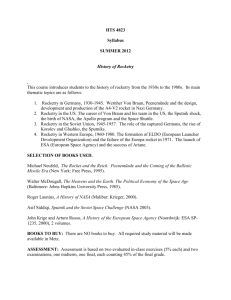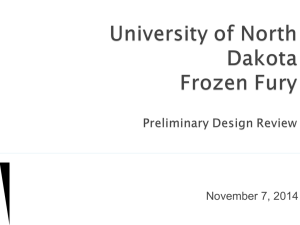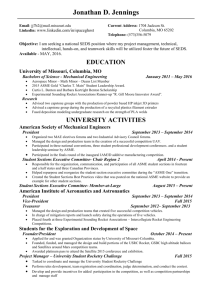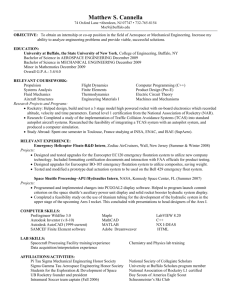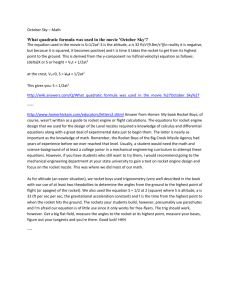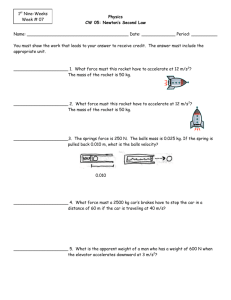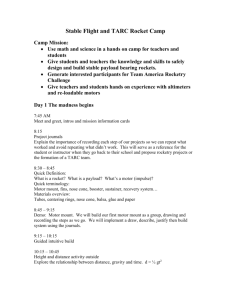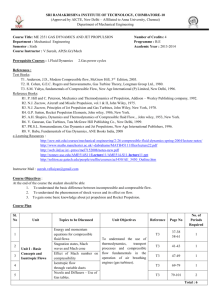here - Texas A&M University
advertisement
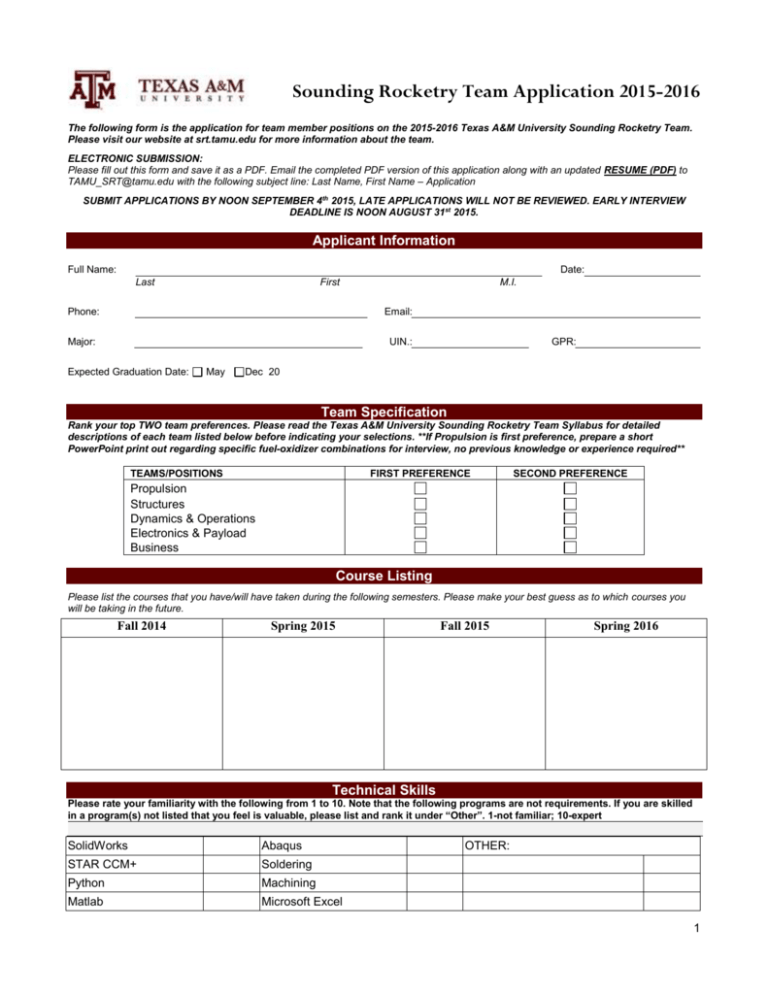
Sounding Rocketry Team Application 2015-2016 The following form is the application for team member positions on the 2015-2016 Texas A&M University Sounding Rocketry Team. Please visit our website at srt.tamu.edu for more information about the team. ELECTRONIC SUBMISSION: Please fill out this form and save it as a PDF. Email the completed PDF version of this application along with an updated RESUME (PDF) to TAMU_SRT@tamu.edu with the following subject line: Last Name, First Name – Application SUBMIT APPLICATIONS BY NOON SEPTEMBER 4th 2015, LATE APPLICATIONS WILL NOT BE REVIEWED. EARLY INTERVIEW DEADLINE IS NOON AUGUST 31st 2015. Applicant Information Full Name: Date: Last First M.I. Phone: Email: Major: UIN.: Expected Graduation Date: May GPR: Dec 20 Team Specification Rank your top TWO team preferences. Please read the Texas A&M University Sounding Rocketry Team Syllabus for detailed descriptions of each team listed below before indicating your selections. **If Propulsion is first preference, prepare a short PowerPoint print out regarding specific fuel-oxidizer combinations for interview, no previous knowledge or experience required** TEAMS/POSITIONS FIRST PREFERENCE SECOND PREFERENCE Propulsion Structures Dynamics & Operations Electronics & Payload Business Course Listing Please list the courses that you have/will have taken during the following semesters. Please make your best guess as to which courses you will be taking in the future. Fall 2014 Spring 2015 Fall 2015 Spring 2016 Technical Skills Please rate your familiarity with the following from 1 to 10. Note that the following programs are not requirements. If you are skilled in a program(s) not listed that you feel is valuable, please list and rank it under “Other”. 1-not familiar; 10-expert SolidWorks Abaqus STAR CCM+ Soldering Python Machining Matlab Microsoft Excel OTHER: 1 Short Answer Please answer the following questions to the best of your ability, as concisely as possible (300 characters max, each). Why are you interested in joining the Texas A&M University Sounding Rocketry Team and what do you hope to gain personally from this experience? What would you like to contribute to the Texas A&M University Sounding Rocketry Team, if selected? Please also include the number of hours willing to commit per week to the project. Explain your reasoning behind selecting the above preferences for the team specification. What are your aspirations after graduating from A&M? (Graduate school, academia, industry, dream job, etc.) Or, if you have any current commitments after graduating, please include those below. List below any past/current membership/leadership involvement in any other organizations. Disclaimer and Signature By signing (physically or electronically) the line below, you are certifying that the information you have entered above is both truthful, accurate, and to the best of your knowledge. Also, you are agreeing to actively participate, if selected, on the 2015-2016 Texas A&M University Sounding Rocketry Team for both semesters of the 2015-2016 academic school year. AGGIE CODE OF HONOR: “An Aggie does not lie, cheat or steal, nor tolerate those who do.” Applicant Signature: Date: For official use only: Reviewed By: Date: Reviewed By: Date: 2 Team Descriptions & Responsibilities BUSINESS This team consists of a Business Manager and 2 Business Coordinators. Individuals will be responsible for all business aspects of the team. This includes finding and convincing sponsors to donate money, managing team finances, registering the team for competition, managing the team’s website and social media accounts, and organizing social events. As a member of this team, you will have a high degree freedom in solving realistic business challenges. SRT is self-funded and therefore very much like a start-up or research company; the team doesn’t have a product to sell, but must instead convince sponsors to invest in our concept and model. Members of this team must not only be very organized, but also extremely outgoing and professional since there will be a great deal of interaction between the business coordinator, school administrators, potential sponsors, and the competition officials. Above all, excellent communication skills are a must. PROPULSION The Propulsion team consists of a team manager and 5 general members who will design, build, and test the propulsion system(s) of the rocket. Each year comes with different needs/desires/ambitions, so each engine built is unique to that year’s talent. Hybrid engines have been and will likely continue to be the design of choice for this organization. Parts of the hybrid system include the oxidizer tank, valve assembly, injector plate, combustion chamber, and nozzle. All parts will be designed, built, and tested by team members. Successful completion of tasks will require the use of thermodynamics, chemistry, high speed aerodynamics, and extensive use of SolidWorks and CFD programs (FlowSim, Star-CCM+, etc.) as well as other programs such as Matlab. Skills with these programs are an added benefit, but are not required. Regardless of skill level, an individual applying for this team must be able to learn quickly and retain information. This is a very hands on team and will require a dedicated personality, willingness and ability to contribute a fairly significant amount of time and effort while managing challenging course work. STRUCTURES The Structures team consists of a team manager and 4 general members who will be tasked with the material selection, design, and manufacture of the rocket’s body tubes, bulkheads, and recovery system, in addition to the material selection for and manufacture of the nosecone and fins. A preliminary design of each of the structural components will be developed using SolidWorks and then analyzed using Abaqus and Matlab to verify and optimize their structural integrity. Special attention will be given to potential high stress areas, such as the recovery bulkhead, which supports the drogue and main parachute loads upon deployment. Mechanical design, FEA, and machining experience is desired, but not required. DYNAMICS AND OPERATIONS The Dynamics and Operations team consists of a manager and 4 general members, tasked with creating a trajectory model and designing the rocket's aerodynamic surfaces (nosecone, fins). Within the trajectory model, flight characteristics such as altitude, velocity, and stability will be of main concern. To make design choices regarding the aerodynamic surfaces, established aerodynamic literature and analysis programs such as Matlab and STAR CCM+ will be used. A scale model of the final rocket will placed in a wind tunnel, and data will be collected/analyzed to confirm results previously procured from calculations and simulations. The culmination of this process will a stable and aerodynamically sound rocket, a product of educated design choices. To accomplish this, members will be expected to consider all factors of a design problem, thoroughly document their work, and be detail-orientated while maintaining a long term, “big picture” vision. An understanding of aerodynamic concepts and a strong work ethic is necessary. ELECTRONICS AND PAYLOAD The Electronics and Payload team consists of a team manager and 4 general members who will be in charge of designing, programming, and building the rocket’s electronics bay and payload in addition to the development any other electrical systems needed for launching or testing. The electronics bay will serve as the brain of the rocket and will collect flight data and control any ignition, staging, or parachute ejection events by using microcontrollers, sensors, and flight computers. Other than the fact that the payload must weigh at least 10 lbs and have scientific merit (as defined by ESRA competition rules), the members of this team will have complete freedom in the choice and design of the rocket’s payload. This team’s work will require some programming experience (Python, Labview, etc.), some familiarity with electronics, and most importantly a desire to learn. 3
